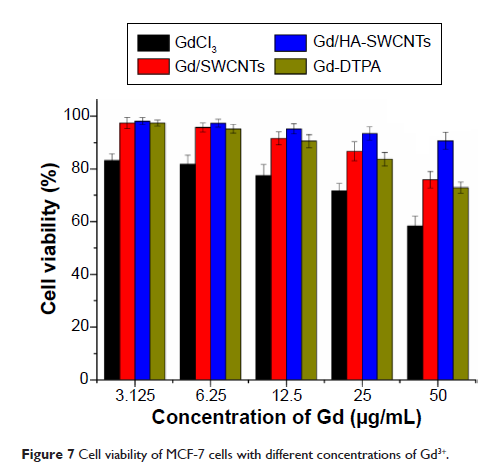108384
论文已发表
注册即可获取德孚的最新动态
IF 收录期刊
- 3.4 Breast Cancer (Dove Med Press)
- 3.2 Clin Epidemiol
- 2.6 Cancer Manag Res
- 2.9 Infect Drug Resist
- 3.7 Clin Interv Aging
- 5.1 Drug Des Dev Ther
- 3.1 Int J Chronic Obstr
- 6.6 Int J Nanomed
- 2.6 Int J Women's Health
- 2.9 Neuropsych Dis Treat
- 2.8 OncoTargets Ther
- 2.0 Patient Prefer Adher
- 2.2 Ther Clin Risk Manag
- 2.5 J Pain Res
- 3.0 Diabet Metab Synd Ob
- 3.2 Psychol Res Behav Ma
- 3.4 Nat Sci Sleep
- 1.8 Pharmgenomics Pers Med
- 2.0 Risk Manag Healthc Policy
- 4.1 J Inflamm Res
- 2.0 Int J Gen Med
- 3.4 J Hepatocell Carcinoma
- 3.0 J Asthma Allergy
- 2.2 Clin Cosmet Investig Dermatol
- 2.4 J Multidiscip Healthc

玻尿酸官能化的单壁碳纳米管作为肿瘤靶向的磁共振 (MRI) 造影剂
Authors Hou L, Zhang H, Wang Y, Wang L, Yang X, Zhang Z
Published Date July 2015 Volume 2015:10 Pages 4507—4520
DOI http://dx.doi.org/10.2147/IJN.S78563
Received 2 December 2014, Accepted 27 April 2015, Published 16 July 2015
Abstract: A tumor-targeting
carrier, hyaluronic acid (HA)-functionalized single-walled carbon nanotubes
(SWCNTs), was explored to deliver magnetic resonance imaging (MRI) contrast
agents (CAs) targeting to the tumor cells specifically. In this system, HA
surface modification for SWCNTs was simply accomplished by amidation process
and could make this nanomaterial highly hydrophilic. Cellular uptake was
performed to evaluate the intracellular transport capabilities of HA-SWCNTs for
tumor cells and the uptake rank was HA-SWCNTs> SWCNTs owing to the presence
of HA, which was also evidenced by flow cytometry. The safety evaluation of
this MRI CAs was investigated in vitro and in vivo. It revealed that HA-SWCNTs
could stand as a biocompatible nanocarrier and gadolinium (Gd)/HA-SWCNTs
demonstrated almost no toxicity compared with free GdCl3. Moreover,
GdCl3 bearing HA-SWCNTs could significantly increase the circulation
time for MRI. Finally, to investigate the MRI contrast enhancing capabilities
of Gd/HA-SWCNTs, T1-weighted MR images of tumor-bearing mice were
acquired. The results suggested Gd/HA-SWCNTs had the highest tumor-targeting
efficiency and T1-relaxivity enhancement, indicating HA-SWCNTs could
be developed as a tumor-targeting carrier to deliver the CAs, GdCl3,
for the identifiable diagnosis of tumor.
Keywords: gadolinium, magnetic
resonance, SWCNTs, hyaluronic acid, contrast agent
